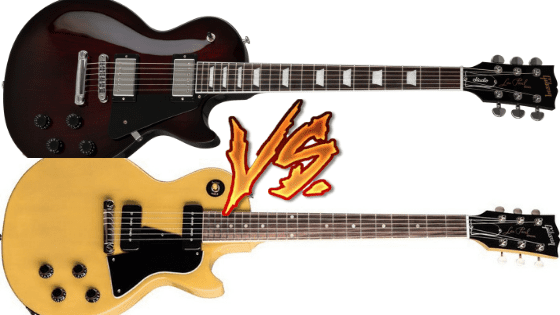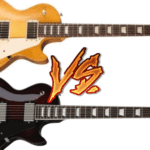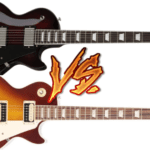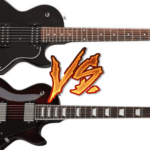Finding the particular specs of 2 guitars online is quite some work.
In many cases, the manufacturers don’t inform the same features about the instruments that you want to compare and you have to start digging all over the web to find them.
But hey, relax!
If you are here, it seems like I have already done that job for you.
Here is a brief description of these 2 guitars:
The Gibson Les Paul Studio is made in USA, has a solid (ultra modern weight relief) mahogany body, a set Slim Taper “C” mahogany neck, rosewood fingerboard, and HH pickups. The Gibson Les Paul Special is made in USA has a solid mahogany body, a set Vintage 50s “C” mahogany neck, rosewood fingerboard, and PP pickups.
The Gibson Les Paul Studio has Grover Rotomatics tuners, 490R Humbucker pickups, and Coil-tapping electronics. The Gibson Les Paul Special has Vintage Deluxe tuners, P-90 pickups, and Standard electronics.
For those who want a deeper dive into all the specs that make these 2 guitars different, in this article I will put them side by side so you can see their main differences.
After that, I will show you some sound tests I found, and give you a brief history of each one of them.
I will then talk about their main specs one by one, and link you to some other interesting articles I have written about these specific features.
Finally, I will give you some comments about each of these instruments.
Are you ready to get started?
Let’s go!
Gibson Les Paul Studio and Gibson Les Paul Special side by side
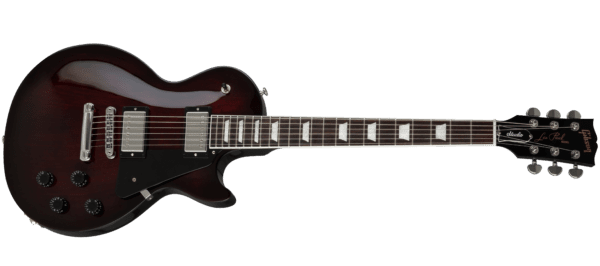
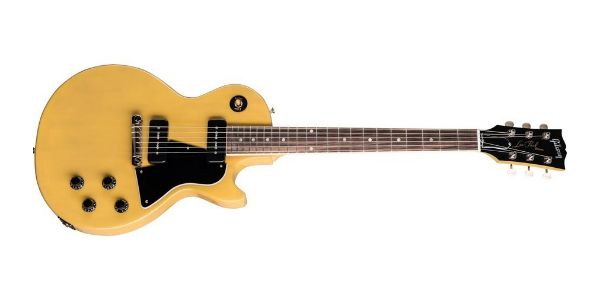
| Spec | Gibson Les Paul Studio | Gibson Les Paul Special |
| Years of production | Since 1983 | Since 2019 |
| Made in | USA | USA |
| Body type | Solid (Ultra Modern Weight Relief) | Solid |
| Body shape | Les Paul | Les Paul Special |
| Body material | Mahogany | Mahogany |
| Top material | Maple | |
| Finish | Gloss Nitrocellulose | Gloss Nitrocellulose |
| Neck material | Mahogany | Mahogany |
| Neck shape | Slim Taper “C” | Vintage 50s “C” |
| Headstock shape | Gibson | Gibson |
| Neck joint | Set | Set |
| Fingerboard material | Rosewood | Rosewood |
| Fingerboard radius | 12″ | 12″ |
| Number of frets | 22 | 22 |
| Fret material | Nickel Silver | Nickel Silver |
| Fret size | Medium Jumbo | Medium Jumbo |
| Scale length | 24.75″ | 24.75″ |
| Bridge | Nashville Tune-O-Matic | Wraparound |
| Tailpiece | Stopbar | Bridge integrated |
| Nut | GraphTech | GraphTech |
| Tuners | Grover Rotomatics | Vintage Deluxe |
| Pickup configuration | HH | PP |
| Neck pickup | 490R Humbucker | P-90 |
| Middle pickup | ||
| Bridge pickup | 490T Humbucker | P-90 |
| Electronics | Coil-tapping | Standard |
| Controls | 2 x Volume, 2 x Tone | 2 x Volume, 2 x Tone |
| Switching | 3-Way Toggle | 3-Way Toggle |
| Weight | 8 lbs | 7 – 8 lbs |
| Players | Slash, Gary Moore, Jimmy Page, Zakk Wylde, Billy Gibbons, Randy Rhoads, Ace Frehley, Joe Perry, Peter Green | Billie Joe Armstrong, Johnny Marr, Carlos Santana, Billy Corgan, Luke Hemmings, Nick Valensi, Lee Ranaldo, Kim Gordon, Ace Frehley, Ronnie Wood |
| Case | Softshell case | Hardshell case |
| Price | $1499 | $1599 |
What do they sound like?
Gibson Les Paul Studio play demo
Gibson Les Paul Special play demo
Brief descriptions
A brief description of the Gibson Les Paul Studio
“The Gibson Les Paul Studio is celebrated by live performers and session players alike. The modern Studio covers even wider sonic territory with its coil-tapped 490R/498T humbucking pickups. This combination unlocks plenty of creative textures to flesh out musical ideas, from classic cleans and modern crunch to single-coil cluck. This Studio also benefits from an Ultra-modern weight-relieved body; this reduction of more than a pound in weight provides extra comfort for extended sessions and performances. A feature your fingers will thank you for is the SlimTaper mahogany neck, which re-creates the speed and playability that some of the ’60s Les Pauls are known for. Dependable Grover Rotomatic tuners keep this Gibson Les Paul Studio pitch-perfect and ready to rock.”
Source: Sweetwater.com
A brief description of the Gibson Les Paul Special
“Countless players have found the Gibson Les Paul Special, with its lightweight design and unique tonal response, to be easy to pick up yet impossible to put down. So it is with today’s Les Paul Special; its easy-gigging weight and P-90 chunk ’n’ chime will earn this guitar a special place in any serious guitarist’s collection. A breathable nitrocellulose lacquer finish, handwired electronics, and a vintage ’50s mahogany neck make this single-cut a dead ringer for yesterday’s sought-after classics. Yet modern performance options, which include a factory fret Plek treatment, make today’s Gibson Les Paul Special a force to be reckoned with.”
Source: Sweetwater.com

Body type
The Gibson Les Paul Studio has a solid (ultra modern weight relief) body. The Gibson Les Paul Special is built with a solid body.
As you probably know, the body type of a guitar is a defining factor for its character and tone.
If you want to know more about how these kinds of bodies affect these guitars, you can check out this article:

Body shape
The Gibson Les Paul Studio has a Les Paul body. The Gibson Les Paul Special is built with a Les Paul Special body.
The shape of a guitar’s body has serious implications on its playability, but not so much on its tone.
If you want to know everything about the effect of guitar body shapes, and their influence on the instrument, check out this article:

Body material
The Gibson Les Paul Studio has a solid (ultra modern weight relief) mahogany body. The Gibson Les Paul Special is built with a solid mahogany body.
The kind of material used to build a guitar’s body is something you should really pay attention to.
This is one of the main factors that define the tone of an instrument.
If you want to know how these specifics materials impact the tone of these guitars, you should take a look here:

Top material
Guitarists are often curious about how guitar tops affect tone.
There are many factors that contribute to the sound of a guitar, and whether it has a top is an important one. With so many options on the market, it can be difficult to make a decision.
The following article will explain what guitar tops are and why they matter, as well as provide guidance for those who want to learn more about these options.
In short, a guitar’s top has a slight, but perceivable, influence on its tone, however, they are mostly used for aesthetic purposes.
Whether your preferred guitar has one or not, it shouldn’t worry you too much.
However, if you want to know all there is about guitar tops, go here:

Finish
The Gibson Les Paul Studio has a gloss nitrocellulose finish. The Gibson Les Paul Special is painted with a gloss nitrocellulose finish.
Guitar players know that there are many variables in determining the sound of a guitar. Yet, one of the most popular debates is about nitro vs poly.
Let’s explore this question, so you can make an informed decision for your next purchase.
These 2 finishes are both types of varnish that can be used to protect and beautify a guitar’s wood. They also have slightly different properties that some players argue can influence the tone of your guitar.
Nitro is a type of varnish that is thinner and less durable, while poly is thicker, way more durable, and cheaper.
Poly provides more protection from moisture and scratches, but some people argue it reduces resonance and sustain. Nitro wears off with time but has a more organic feel to the touch and is said to improve sustain and resonance.

Neck material
The Gibson Les Paul Studio has a mahogany neck. The Gibson Les Paul Special is built with a mahogany neck.
The type of wood that a guitar neck is made of will have a significant impact on the tone of your guitar.
Tonewoods have different densities, hardness, and acoustic qualities.
The type of wood a guitar neck is built with will determine its final sound.
In the following article I present you a list of the most common tonewoods used in guitar necks, and the influence they could have on the tone of the instrument:

Neck shape
The Gibson Les Paul Studio has a Slim Taper “C” neck. The Gibson Les Paul Special is built with a Vintage 50s “C” neck.
The shape of a guitar neck has a significant impact on the tone and playability.
Guitar necks come in a variety of shapes, so it’s important to know what each of those shapes offers.
Luckily for you, I’ve compiled some general information about each different type of guitar neck shape so you can make an informed decision when choosing your next guitar:

Headstock shape
The Gibson Les Paul Studio has a Gibson headstock. The Gibson Les Paul Special is built with a Gibson headstock.
The shape of a guitar’s headstock is not really a big defining factor for its tone.
However, many players argue that differences in mass, especially at the end of the neck can have some implications in tone.
In this article I go deep into that topic and answer the most pressing questions:

Neck joint
The Gibson Les Paul Studio has a set neck. The Gibson Les Paul Special is built with a set neck.
Guitar necks come in a variety of different joints, and each one has its own pros and cons.
Knowing the differences between each joint can help you decide which is best for you.
A guitar’s neck joint is what attaches the guitar’s neck to the body of the instrument.
There are 3 types of neck joints: bolt-on, set, and neck through.
Bolt-on necks are attached by screws at the heel of the neck and can be removed easily for repairs or customization.
Set necks attach to a pocket in the guitar’s body and stay put with glue.
In neck trough instruments, the neck elongates and becomes the central piece of the body, where most of its hardware is mounted. Then, there are wood “wings” glued to its side to complete the body shape.
If you want to know the specifics of each of these joints, check out this article:

Fingerboard material
The Gibson Les Paul Studio fretboard is made of rosewood. The Gibson Les Paul Special fretboard is built of rosewood.
The material of a guitar’s fingerboards is as important as the one of the rest of the neck.
In conjunction, both these 2 parts have a deep impact on the final tone of the instrument.
Also, take into consideration that the fretboard is the point of contact for your playing fingers with the guitar, so feel is also a very important factor.
In the following article, I share my thoughts on different fingerboard materials and their impact on the final sound of the instrument:

Fingerboard radius
The Gibson Les Paul Studio has a 12″ radius. The Gibson Les Paul Special is built with a 12″ radius.
The radius of the fingerboard is a measure of how curved the neck of the guitar actually is when looking at it from bridge to nut.
This curvature is really a defining factor for how the instrument plays, and some players are very strict about it.
If you want to know more about how it’s measured and the effect it has on the playability of a guitar, you should look at the following article:

Frets
The Gibson Les Paul Studio has 22 medium jumbo nickel silver frets. The Gibson Les Paul Special is built with 22 medium jumbo nickel silver frets.
The frets on a guitar have a deep impact on its playability.
Many players don’t consider this as important as other features, but more experienced ones will be very picky about this.
Bigger frets make a guitar easier to play, however, they hinder the overall intonation of the instrument.
Also, there are different fret materials to consider.
In these articles, I dive deep into how important are frets for a guitar.

Scale length
The Gibson Les Paul Studio has a 24.75″ scale length. The Gibson Les Paul Special is built with a 24.75″ scale length.
The scale length of a guitar refers to the longitude of the vibrating part of the string.
This is measured from the nut to the bridge, and for intonation purposes, the middle point is always the 12th fret.
Different scale lengths have varying influences over things such as string tension, and of course, fret gap size.
If you want to know more about this, I invite you to read the post below:

Bridge
The Gibson Les Paul Studio has a Nashville Tune-O-Matic bridge. The Gibson Les Paul Special is built with a Wraparound bridge.
A guitar’s bridge is one of the 2 points of contact the strings have with the body and neck.
It is a central part for the transmission of vibrations through the instrument, and also defines many important factors for playability such as string spacing and action.
Some bridges also have extra functionalities.
To know everything there is about this part of the guitar, please go here:

Tailpiece
The Gibson Les Paul Studio has a stopbar tailpiece. The Gibson Les Paul Special is built with a bridge integrated tailpiece.
Tailpieces are often forgotten when thinking about guitar parts, however, they have been there for centuries, and there are many different designs with alternate features.
Whether your guitar has a standalone one or a bridge that works like one too, you might be interested in broadening your knowledge about tailpieces here:

Nut
The Gibson Les Paul Studio has a graphtech nut. The Gibson Les Paul Special is built with a graphtech nut.
The nut of a guitar is a small but very important part of the instrument.
It helps define string spacing, action, and is the source of many of the tuning issues cheaper instruments suffer from.
There are many kinds and materials of nuts out there, and if you want to know how they can impact your instrument of choice, you should go to this article:

Tuners
The Gibson Les Paul Studio has Grover Rotomatics tuners. The Gibson Les Paul Special is built with Vintage Deluxe tuners.
Guitar tuners don’t have a direct effect on how a guitar sounds.
However, their quality will be a defining factor in your playing experience.
It’s fundamental that your instrument has good quality machine heads to keep it in tune.
In the following article, I dive deep into the most common questions players ask about tuners, and their functionality:

Pickups
Guitar pickups are one of the main components of any electric guitar.
But do guitar pickups make a difference in sound? This can be a difficult question with many different answers.
The most important thing to note is that it is not just the type of pickup that determines a guitar’s sound, but also how and where you place the pickup on the guitar.
In this guide, we will discuss the different types of pickups and how they affect your sound.
We will outline how pickups work and what are the central factors that determine how they influence the tone of your instrument.
Finally, we will help you compare different models and make an informed decision about which pickup is right for you.

Electronics
The Gibson Les Paul Studio has coil-tapping electronics, 2 x volume, 2 x tone controls, and a 3-way toggle switch. The Gibson Les Paul Special is built with standard electronics, 2 x volume, 2 x tone controls, and a 3-way toggle switch.
The electronics of an electric guitar are what gives the instrument its name. However, because they are hidden inside the cavities into its body, they are often forgotten.
Controls, switches, capacitors and resistances, all make for the circuitry of a guitar, and all have effects on the final tone and sounds it can offer to the player.
If you want to know the main things about this topic, I recommend you follow this link:

Weight
The Gibson Les Paul Studio weighs 8 lbs, and the Gibson Les Paul Special weighs 7 – 8 lbs.
Guitar weight is an important factor when it comes to finding the right guitar for you.
A heavier guitar will give you more sustain, but a lighter guitar will be more resonant, and easier to play and carry around.
However, there’s no single answer to whether a lighter or heavier guitar will sound better than the other.
There are also many factors that could determine what weight of guitar would be best for you.
Here, I explore some of these considerations and what I think are the main points to take into account:
Final comments
The Gibson Les Paul Studio is a classic alternative for players who want a vintage Les Paul sound for a more affordable price tag.
The Gibson Les Paul Special is a reissue of the legendary Les Paul Special, this time with Gibsons’ growling P-90 pickups, and the tonal versatility a 2 pickup guitar facilitates, at a rather affordable price point for an American guitar.
Which one do you think you like better?

Hello there, my name is Ramiro and I’ve been playing guitar for almost 20 years. I’m obsessed with everything gear-related and I thought it might be worth sharing it. From guitars, pedals, amps, and synths to studio gear and production tips, I hope you find what I post here useful, and I’ll try my best to keep it entertaining also.

